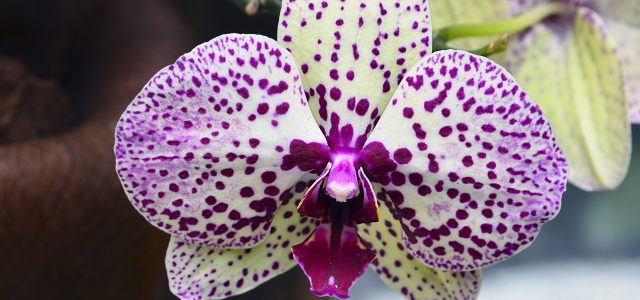
CARING FOR ORCHIDS
Orchids are elegant, beautiful plants. However if you want them to keep flowering for you they need a little TLC, advises expert George Williams
The most popular orchids sold as house plants are the phalaenopsis and the dendrobim hybrids – both of which are epiphyte orchids. To keep them successfully it is important to remember that both of these need to be kept in conditions as close as possible to their natural environment.
TOP TIPS
When you get your orchid home, there is no need to re-pot it. Place it in a light position, like an east-facing windowsill, and enjoy its beauty.
When the flowers fall don’t panic! A little patience and care will see it flowering again in no time. Simply use a pair of sterile snippers, and cut-off the dead flower spike.
Orchids thrive when planted in specialist pots – their roots need light and drainage. These are widely available, clear plastic pots with wide drainage slits, allowing water to run freely through the roots and drain away – so the plant isn’t sitting in water.
The potting mixture for an orchid is usually composed of a variety of chunky ingredients, such as pine bark, charcoal and on occasion, styrofoam.
Orchids should be re-potted every two years:
• Take the orchid out of its original plastic pot and try to remove as much of the surrounding moss as possible.
• If you find any rotten or blackened roots, cut them away. Healthy roots look white and firm, often with a small green growing point.
• Place your orchid into its new clear plastic pot and fill around it with potting mixture. Allow the plant to be potted firmly, but not completely anchored. Over time, new roots will grow within the potting mixture and attach to the pot itself.
• Place your orchid on an east-facing windowsill, so it can enjoy a few hours of mild morning sun. Pop the plant onto a gravel-filled tray that’s fairly deep and wide. This will mimic the humidity of an orchid’s natural environment and catch the water run-off.
Orchids are pretty resilient plants, so caring for them is not too complicated. Keep them well watered in summer (weekly) and less in winter (monthly) and never leave them standing in water. Allow the water to flow through the pot and fill your gravel tray.
Mist its leaves and roots on a regular basis, and when your orchid is flowering give it a little feed every week using one of the weaker powder or liquid fertilisers.
If you see the leaves start to wrinkle and yellow, play around with the conditions until your plant responds positively. Try placing it on a different window-sill, move it away from draughts, ensure it has plenty of light, and check the gravel tray has some water in it to give the humidity it needs.
Orchids do require a little bit of TLC. So, follow these tips and your orchid will give you wonderful flowers that you will enjoy all year round.

